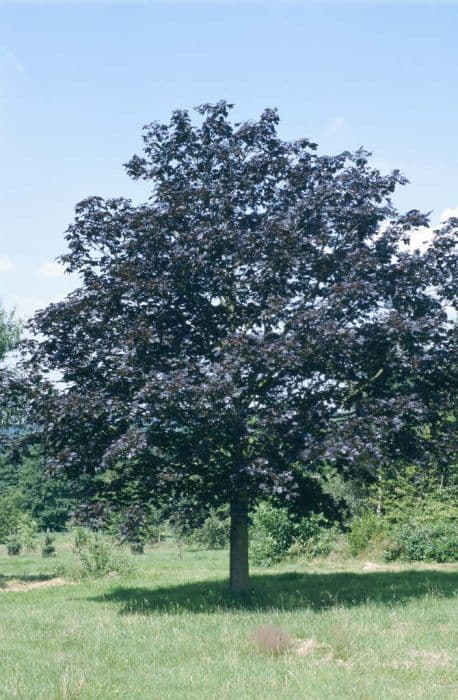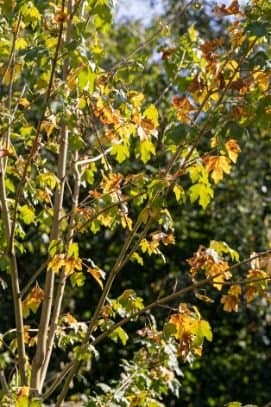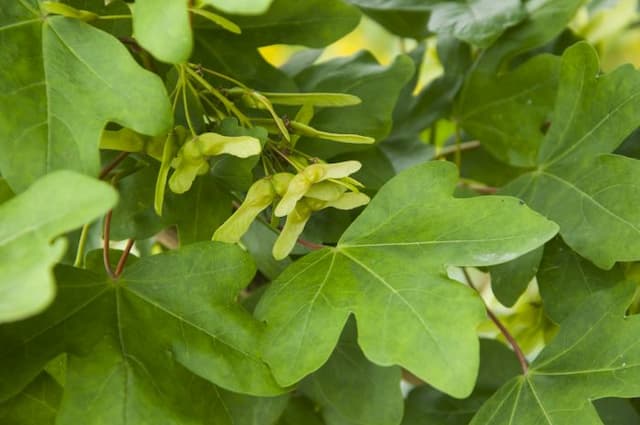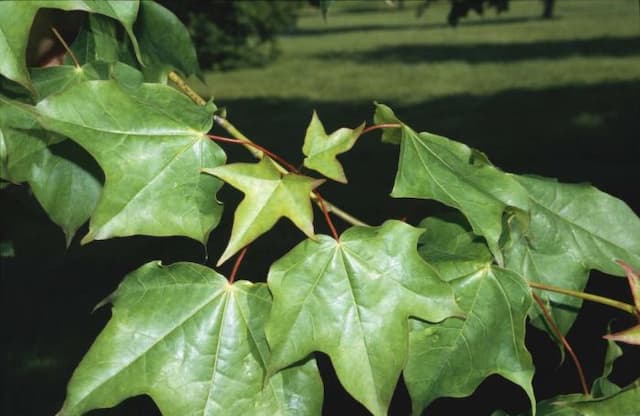Crimson King Maple Acer platanoides 'Crimson King'

ABOUT
The Crimson King maple is distinguished for its eye-catching foliage that sets a dramatic tone in the landscape. This ornamental tree showcases leaves that are a deep, rich maroon or burgundy throughout the growing season, contrasting sharply with the more typical green of other trees. The leaves are shaped like a classic maple leaf, with five pointed lobes, and are arranged in an opposite leaf configuration on the branches. During the spring, small flowers may appear, adding a subtle flourish to the tree's overall visual impact. These flowers are usually followed by samaras, which are the winged fruits characteristic of maples, often known colloquially as helicopters due to their swirling descent to the ground. The Crimson King maple has a dense and rounded crown, presenting a full, lush appearance. Its bark is gray and fairly smooth when the tree is young, but as it matures, the bark develops furrows, and the texture becomes more rugged and corky. Its striking coloration and attractive form make the Crimson King maple a sought-after choice for those looking to make a statement in their landscapes with a bold splash of color that endures from spring until fall.
About this plant
 Names
NamesFamily
Sapindaceae.
Synonyms
Crimson King Maple, King Crimson Norway Maple, Red Norway Maple.
Common names
Acer platanoides 'Crimson King'.
 Toxicity
ToxicityTo humans
The Acer platanoides 'Crimson King', commonly known as Norway Maple, is not considered highly toxic to humans. In most cases, ingestion of this plant might cause minor gastrointestinal discomfort, such as nausea or vomiting. However, it is not associated with severe poisoning or fatal consequences when ingested in small quantities. To avoid any risk, it is advisable not to ingest any parts of this plant.
To pets
The Norway Maple is not typically known for being highly toxic to pets. If a pet ingests parts of this plant, they might experience mild gastrointestinal upset, which could include symptoms such as vomiting or diarrhea. While not usually serious, if a pet consumes a large amount of the plant, or if symptoms persist, it is advisable to contact a veterinarian. It is generally recommended to prevent pets from ingesting plants that are not meant for consumption.
 Characteristics
CharacteristicsLife cycle
Perennials
Foliage type
Deciduous
Color of leaves
Maroon
Flower color
Yellow-green
Height
35-45 feet (10.7-13.7 meters)
Spread
25-40 feet (7.6-12.2 meters)
Plant type
Tree
Hardiness zones
3-7
Native area
Europe
Benefits
 General Benefits
General Benefits- Aesthetic Appeal: The 'Crimson King' maple is highly valued for its ornamental qualities, with deep burgundy or maroon foliage that adds stunning color to landscapes.
- Shade Provider: Its dense canopy provides ample shade, making it a popular choice for parks, large gardens, and areas where summer shade is desired.
- Seasonal Interest: This variety offers year-round interest with its striking foliage, and changes in leaf color from spring to fall add dynamic visual effects to the planting area.
- Drought Resistance: Once established, the 'Crimson King' maple has moderate drought tolerance, reducing the need for frequent watering during dry periods.
- Urban Tolerant: The tree adapts well to urban conditions, tolerating a degree of air pollution and soil compaction, which makes it suitable for city planting.
- Low Maintenance: It generally requires minimal pruning and upkeep once it's established, which can be ideal for landscape designs looking for lower maintenance options.
- Habitat Support: Its canopy can provide habitat for various species of birds and insects, contributing to local biodiversity.
- Erosion Control: Like many large trees, it helps prevent erosion by stabilizing the soil with its root system.
- Longevity: With the right care and environmental conditions, this maple variety can live for several decades, offering long-term benefits to its surroundings.
 Medical Properties
Medical PropertiesThis plant is not used for medical purposes.
 Air-purifying Qualities
Air-purifying QualitiesThis plant is not specifically known for air purifying qualities.
 Other Uses
Other Uses- The leaves of the 'Crimson King' maple can be used to create natural dyes for textiles, imparting a variety of colors depending on the mordant used.
- Wood from the tree is sometimes used in woodworking and is valued for its density and fine grain, especially in turning projects and ornamental work.
- The 'Crimson King' maple's distinctive red-purple leaves can be pressed and used in art projects or as a natural decoration for crafting unique bookmarks or greeting cards.
- Fallen leaves from the tree provide a colorful mulch for garden beds, which can help retain soil moisture and add aesthetic appeal to landscapes.
- In education, the tree can be an effective tool for teaching about different leaf types and tree identification due to its unique foliage color.
- Photographers and artists may use the 'Crimson King' as a stunning backdrop or subject due to its vibrant foliage.
- The bark of the tree can be used in decorative crafts or as a rustic addition to terrariums and fairy gardens.
- During fall, the tree's vivid foliage can be used as a natural indicator to observe and study the change of seasons in climate studies.
- The dense canopy of a 'Crimson King' maple provides habitat and nesting opportunities for birds and small mammals.
- As a distinctive and charismatic landscape feature, the 'Crimson King' can increase property values and contribute to the aesthetic appeal of residential and commercial developments.
Interesting Facts
 Feng Shui
Feng ShuiThe Norway Maple is not used in Feng Shui practice.
 Zodiac Sign Compitability
Zodiac Sign CompitabilityThe Norway Maple is not used in astrology practice.
 Plant Symbolism
Plant Symbolism- Strength and Endurance: As a variety of the Norway maple, the 'Crimson King' shares the maple tree's symbolism of strength due to its sturdy nature and resilient wood.
- Uniqueness and Individuality: The 'Crimson King' stands out with its distinctive dark red-purple foliage, symbolizing individuality and the celebration of one's unique traits.
- Wisdom and Knowledge: Maples are often associated with wisdom and knowledge, partly due to their long lifespan and their common presence on academic grounds.
- Balance and Harmony: The tree's symmetrical shape and the pleasant aesthetic of its leaves can represent balance and harmony in life.
 Water
WaterThe Crimson King Maple requires watering once or twice a week, providing deep irrigation to help establish a robust root system. During dry spells or extreme heat, increase the frequency to ensure the soil remains consistently moist but not waterlogged. Provide the tree with 10 to 15 gallons of water per session, making sure to water slowly at the base to allow for deep soil penetration. Adjust the amount and frequency as needed based on rainfall, temperature, and soil conditions.
 Light
LightThe Crimson King Maple thrives in a location that receives full sun to partial shade. The ideal spot would allow for at least six hours of direct sunlight daily, with some protection from harsh afternoon sun. Ensure that the tree is planted in a space where it has room to grow both upwards and outwards without being shaded by nearby structures or trees.
 Temperature
TemperatureThe Crimson King Maple is hardy and adaptable, tolerating a wide range of temperatures. Ideal growth occurs between 60°F and 70°F, but the tree can survive in temperatures as low as -40°F and as high as 90°F. It is important to avoid temperature extremes during the initial planting and establishment phase to reduce stress on the young tree.
 Pruning
PruningPruning the Crimson King Maple is necessary to remove any dead, damaged, or diseased branches and to maintain its shape. The best time for pruning is in late winter or early spring before the sap starts to flow. Prune sparingly and selectively, as this tree can be sensitive to heavy cutting. Depending on growth and structural integrity, pruning may be needed once every 3 to 5 years.
 Cleaning
CleaningNot needed
 Soil
SoilThe 'Crimson King' Norway Maple thrives in moist, well-draining soil enhanced with organic matter, and prefers a pH ranging from 5.5 to 7.5. A balanced soil mix containing loam, compost, and sand or perlite can support healthy growth.
 Repotting
Repotting'Crimson King' Norway Maples are large trees and do not typically require repotting as they are often planted directly in the ground. However, younger trees might need to be transplanted every few years until they are established.
 Humidity & Misting
Humidity & MistingThe 'Crimson King' Norway Maple is adaptable to a wide range of humidity levels typically found outdoors and does not have specific humidity requirements.
 Suitable locations
Suitable locationsIndoor
'Crimson King' Norway Maples are not suitable for indoor growth.
Outdoor
Plant in full sun to partial shade in well-draining soil.
Hardiness zone
4-7 USDA
 Life cycle
Life cycleThe Norway Maple 'Crimson King' begins its life with seed germination in the spring, following dispersal from the parent tree in autumn. The seedling establishes itself with primary leaves and begins to form a taproot. It progresses into a juvenile phase where it develops a woody stem and true leaves, distinctive for their crimson-purple color. As it matures into an adult tree, it develops a round-to-oval crown and starts flowering typically after 5-7 years, producing small yellow-green flowers that are followed by characteristic winged samaras. The tree reaches reproductive maturity and enters a period of growth and reproduction, producing seeds annually. In its final stage of life, the Norway Maple 'Crimson King' may experience a decline in vigor, potentially succumbing to environmental stressors, pests, or diseases, leading to senescence and eventually death.
 Propogation
PropogationPropogation time
Late winter-early spring
The Norway Maple 'Crimson King' can be propagated through various methods, but the most popular way to propagate this tree is by seed. The seeds, or samaras, should be collected in the fall once they have turned brown and begin to drop from the tree. Seeds require a period of cold stratification to break dormancy; this can be accomplished by mixing the seeds with moist sand or peat moss and storing them in a refrigerator for around 90 to 120 days at temperatures between 33 to 41 degrees Fahrenheit (1 to 5 degrees Celsius). After stratification, seeds can be sown in pots or in a prepared seedbed, ideally in the spring. The seeds should be planted about half an inch (1.27 centimeters) deep and kept consistently moist until germination, which can take several weeks. Once the seedlings have established, they can eventually be transplanted outdoors to their permanent location.







![Freeman maple [Autumn Blaze]](/_next/image?url=https%3A%2F%2Fplants-admin.emdemapps.com%2Fimages%2Fplants%2F%2Fimages%2F604b575b84d87.png&w=640&q=75)

